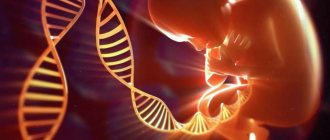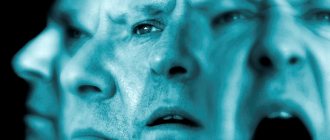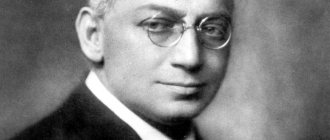Schizophrenia in adolescents often manifests itself unexpectedly and quite violently, usually with vivid manifestations. However, in some cases it can begin unnoticed by parents, who often consider the onset of the disease to be a manifestation of a pubertal state. And this is quite understandable because pubertal manifestations and manifestations of schizophrenia are very similar.
It should be noted that therapy for schizophrenia in adolescents is more effective the earlier it is started. At this age, it is very dangerous to delay treatment. This is due to the fact that schizophrenia in adolescents is dangerous because the degradation phase occurs faster. This is due to the additional load of unstable hormonal levels.
Schizophrenia can affect a person of any age, including adolescence. About 30% of patients first develop symptoms of this disease between the ages of 10 and 20 years. Schizophrenia in adolescents is 4 times higher than in adults.
Schizophrenia in adolescents - signs
Adolescent schizophrenia is a process associated with the formation in a teenager of a pathological mental and emotional state in the perception of the surrounding reality. At the beginning of the development of schizophrenia in adolescents, signs of psychopathy come to the fore: disobedience, aggressiveness, refusal to attend school, sexual deviations.
The main sign of schizophrenia in adolescence is the intensification of negative emotions almost instantly, the occurrence of disturbances in thinking, severe autism, and a decrease in general activity. Adolescent and adult schizophrenia differ significantly. In this age category, the onset of schizophrenia rarely manifests itself in the form of hallucinations and delusions.
Schizophrenia in adolescents
- paranoid - manifests itself as delusion in the form of incorrect interpretation of events and one’s own experiences, dysmorphomania is common (discovery of a defect in appearance that actually does not exist);
- simple - can begin with a difficult character and outbursts of aggression, followed by a sharp decrease in activity and poverty of interests;
- residual - against the background of the absence of acute manifestations of schizophrenia, lethargy, low social activity, and indifference to one’s appearance remain;
- hebephrenic - manifested by elements of child behavior: grimacing, mannerisms, extreme manifestations of autism;
- catatonic – currently quite rare; there is stupor or unproductive motor activity, negativism, freezing in unusual positions.
According to the type of course, schizophrenia is divided into continuous and paroxysmal.
What you need to know
Examinations of patients and analysis of the disease itself allow us to talk about the identity of symptoms and genetics. Symptoms of early childhood schizophrenia are more difficult to identify and determine the type of disease. The complexity lies in the characteristics of the character during the formation of his psyche, general development and cognition - all this cannot be distinguished from purely psychological anomalies. There are several types of development and course of the disease.
Continuous increase. The course lasts about five years. The result is a worsening of the schizophrenic defect. Continuously progressive type, which has subtypes:
- sluggish, when dementia can progress up to twenty years;
- medium, in which the defect matures much faster - up to ten years;
- malignant – the most complex and fastest; this type allows the disorder to be recorded within two to four weeks.
Paroxysmal-progressive type of disease progression. Attacks arise, become dull, stop and occur again.
Characteristics of the paroxysmal subtype are frequent emotional disturbances.
Observations of patients in whom the disease was detected at an early age provide the following statistics: 70% of patients experience an attack-like course of the disease, 25% have a continuously ongoing development. In most cases, the onset of schizophrenia is recorded before the age of five.
Important! In boys, the disease is more common. They are characterized by a sluggish form of the disease, characterized by continuity. In girls, a paroxysmal form is observed that can return. The growth of the defect in them occurs weakly.
Schizophrenia varies in form. The differences depend on the indications of the signs and are classified according to the standards of ICD-10 and DSM-4.
Prevention
Adolescents at risk for schizophrenia should be explained the importance of not taking drugs and alcoholic beverages. Adolescents need to be constantly supported in the development of social skills, prevent the onset of social isolation, formulate the development of relationships with people in a positive way, teach hygiene skills and self-care.
In addition, it is necessary to carry out special psychotherapeutic work, the purpose of which is to talk about the need to lead a healthy lifestyle, take care of your appearance, work to correct the pathological behavior of a teenager and teach formal contacts with others. In the parental family of a sick teenager, it is important to maintain a stable, calm relationship, without physical and moral violence, excessive dependence and uncontrolled behavior. If there is deviant behavior, do not be afraid to show your child to a psychiatrist. Early detection of the disease will prevent the malignant course of the disease and schizophrenia in adolescents can be stopped in advance. Timely treatment of schizophrenia in a teenager is one of the most important factors for success and prevention of degradation processes.
It is important to teach a teenager
- control your behavior and emotions;
- do the work yourself;
- build relationships with others;
- engage in creativity and sports
Types and forms
Paranoid schizophrenia. This is the most common type of disease. It can be diagnosed in 60% of patient examinations. Characterized by all sorts of disorders, this makes it possible to establish a long-term illness. The child may exhibit visual and tactile hallucinations and motor symptoms.
The hebephrenic form has a negative popularity and a critical prognosis. The disease progresses extremely quickly and is continuous. It is often called “adolescent”, as it mainly develops during puberty. And the designation itself is associated with youth (derived from the name of the ancient Greek goddess of youth, Hebe of spring). Traits include emotional distress, delusions, and visions. Manifestations of this form include increased activity, short temper, causeless laughter, sexual outbursts, and unnatural behavior.
Catatonic changes in the behavior of children are long-term and involuntary, characterized by sudden emotional manifestations: crying, laughter, aggression, while increased agitation is observed. In general, intellectual development proceeds without deviations. These disorders have specific symptoms:
- useless running, trampling, disrupted movements;
- disturbed rhythm of chaotic walking, lasting quite a long time without signs of fatigue;
- the child's detached appearance when moving, however, no collision with anything or anyone occurs;
- a sharp change in behavior - lethargy is replaced by activation;
- sudden insomnia that occurs during sleep;
- impulsiveness, aggressiveness.
Childhood schizophrenia is characterized by mild symptoms and anxiety. During the day, the child develops fear of unfamiliar surroundings and strangers. At this time, the baby's appetite is impaired, he refuses to play and remains close to his mother all the time. The progression of the defect makes children's fear more objective. The disappearance of the root cause of fear brings the condition back to normal. Outwardly, deficiencies in the perception of the environment in children are manifested by a wandering gaze that does not linger on anything specific. You can also observe a slightly open mouth.
Schizophrenia in adolescents - symptoms
There are entire symptom complexes that cannot be considered separately from each other; all of them, to one degree or another, are applicable to a number of other diseases. They can only be considered in relation to schizophrenia in aggregate.
- Changes in the emotional sphere (a teenager with schizophrenia experiences great difficulty in expressing emotions, or reacts inadequately to everyday life situations).
- The appearance of delusions, hallucinations are possible (the sick teenager hears voices that do not exist in reality and sees imaginary objects).
- Behavioral disorders in adolescents are expressed in uncontrollability, lack of purposefulness, passivity, indifference to school, running away from home, early alcoholism and primitive interests.
These symptoms do not always appear simultaneously; moreover, they vary and depend on the stage of the disease. It is necessary to begin treatment for schizophrenia in a teenager only after a full differential diagnosis has been carried out.
Differential diagnosis
Schizophrenia in adolescents requires careful diagnosis, because usually this diagnosis accompanies a person throughout his life. Manifestations characteristic of this disease, as a rule, accompany other conditions of a teenager where there are mental disorders. Only a psychiatrist has the right to understand all the manifestations of the disease and make a primary diagnosis - schizophrenia of a certain type. How, among other things, to prescribe therapy and monitor the treatment process.
The main thing in diagnosing schizophrenia is a scrupulous history taking, psychological testing for the adolescent’s personality traits and long-term observation by a group of doctors in a psychiatric hospital. The doctor attaches great importance to data on the use of medications and narcotic drugs, information about the effects of toxic substances, and the possibility of transmitting the disease by inheritance. In addition, to exclude brain pathology, the state of the adolescent’s nervous system is taken into account.
Main symptoms
Schizophrenia often first appears between 15 and 25 years of age. Withdrawal, inability to act, difficulties in communication, mood swings - some symptoms of schizophrenia really resemble manifestations of a teenage crisis. But the diagnosis becomes completely clear when hallucinations, delusions and speech disorders appear.
To hallucinate is to perceive (see, hear or feel) something that does not exist but appears to be real. Hallucination
arises due to the fact that a person perceives some of his unpleasant thoughts or feelings as something that does not belong to him, separate from him, and they take the form of disturbing visions or voices.
For example, a person with severe feelings of guilt may hallucinate a gang of tormentors (symbolizing punishment) who want to kidnap him. Delusions
are false beliefs that persist despite evidence to the contrary.
Through the effort of imagination, a teenager creates for himself a picture of the world that is more understandable and less painful than the real one. This is a way to cope with a situation that is intolerable to him. And although this method is not very good and deprives him of the opportunity to adapt to the environment, at this moment he simply has no other. Delirium helps the patient to associate his anxiety with some object, find an explanation for it, and thereby calm him down at least a little.
During acute conditions, speech disturbances are also observed. The coherence of statements is lost. A teenager with schizophrenia communicates with imaginary characters about an imaginary situation and is unable to clearly tell what is happening to him. Patients also invent new words, giving them a meaning that is understandable to them alone. However, patients have moments of relative peace when they can more easily enter into dialogue.
Stories of adolescent schizophrenia
Case history: Patient V., 18 years old
During adolescence, one can note intolerable, annoying, conflict behavior towards parents and friends. He ran away from home, lived in the basement, drank alcohol and drugs. Smokes. There were cases of theft. I finished 9th grade with difficulty. He entered a vocational school, but did not complete the first year, as he was detained for hooliganism.
Returning home, I decided to go to work. Got a job as a loader in a store. There he liked a girl to whom he began to show strange attention. When he saw a girl, he began to speak very loudly, used obscene language, spat in her direction, compromised her in other ways. In response to her indignation, he scattered the products around the store and broke the display case.
In addition, he began to look unkempt, stopped washing himself, and talked a lot and meaninglessly.
Once he invited a policeman to accompany him on a trip to a restaurant as security. Having received a refusal from him, he initiated a fight. I left my job. He settled in a landfill, was happy and waited there for his beloved. During this period he committed several thefts. As a result, he was detained while trying to take a bag of candy from a child. During hospitalization, he laughed and behaved foolishly, grimaced, and thematic slippage was noted during conversation. There are 4 types of prognosis for schizophrenia.
Forecast
- In general, the prognosis of the disease.
- Forecast of the social plan, training opportunities and further employment.
- Prediction of treatment effectiveness.
- Prognosis in terms of the possibility of homicidal or suicide.
Schizophrenia in adolescents - prognosis
- The male gender is an unfavorable factor, the female gender is more favorable.
- Concomitant organic pathology of the brain worsens the prognosis of schizophrenia.
- A history of heredity for the disease is unfavorable.
- The presence of schizoid character accentuation also has a bad effect on the prognosis.
- A good sign would be an acute onset of the disease, a bad sign would be an unclear, erased onset of the disease.
- It’s bad if the hallucinatory component predominates, but good if the affective component predominates.
- A good sign is the response to the first therapy.
- Long-term and frequent exacerbations also worsen the prognosis.
According to statistics, about 20% of sick teenagers attempt suicide, of which almost 12% die.
The most likely prognosis for the development of the disease in each specific case can be obtained during a consultation in our clinic.
How does schizophrenia occur?
Over the last century, schizophrenia has attracted the attention of scientists from various specialties - clinicians, geneticists, biochemists, immunologists, neurophysiologists, psychologists and many others. Schizophrenia today is considered as a multifactorial disease, that is, manifested as a result of the interaction of biological and environmental factors.
Today, the most widespread are biological hypotheses, and above all, the theory associated with impaired synthesis of neurotransmitters
- chemicals involved in the process of information transmission in brain cells. Scientists have been able to establish the key role of dopamine in the appearance of symptoms of schizophrenia - we are talking about the synthesis of this substance and the sensitivity of nerve cells to it. Less widespread are theories that assign the main role to other mediators, such as serotonin and norepinephrine.
The work of mediators is largely controlled by genes. This means that heredity plays a large role in the development of schizophrenia. The influence of this factor is also supported by data on the prevalence of schizophrenia among blood relatives.
of impaired brain development in the prenatal period has become equally widespread.
and in infancy. Deviations in brain development increase the risk of schizophrenia, and the development of symptoms, i.e., the onset of the disease, is associated with stress factors that cause dysfunction of the corresponding “imperfect” structures.
Drug use can accelerate the progression of the disease and influence the frequency and severity of relapses, which is recognized by most psychiatrists. Even soft drugs lower the barrier between consciousness and the unconscious, and frightening impulses break out from there. In some cases, this provokes illness.
From a biological point of view, adolescence is a period when brain structures are rebuilt. Some neural connections arise, others disappear. Some teens may have “accidents” that impair their ability to cope with stressful situations and strong feelings. But they can only accompany the disease, and its cause lies in something else.
Psychosocial and environmental factors
also contribute to the development of the disease. It has been proven that in families where the patient is criticized, treated with hostility, disapproval or overprotective, relapses of the disease are more common.
There is also a psychoanalytic hypothesis
. According to her, those who unconsciously perceive themselves as part of the mother’s body are prone to illness. Such a person is not able to cope with situations that symbolically represent separation from parents: a school exam, divorce, sexual fantasies, the loss of a loved one. They injure him and can provoke the onset of the disease.
DISEASE SYNDROMES
Schizophrenia in childhood manifests itself in groups of syndromes that cover absolutely all areas of the child’s activity: emotional, social, intellectual, behavioral, volitional. As a result, children lose touch with reality and exist in their own, detached, fictional world.
Apato-abulic syndrome is accompanied by lethargy, lack of initiative, and loss of interests. Behavior is characterized by monotonous, aimless, sluggish movements. Activity decreases sharply. Children lose their inherent cheerfulness. Usually they take one position, sitting like that for quite a long time: standing, lying, sitting, without changing position. Another option is to start walking or running aloofly, completely ignoring people and what is happening around them. Attention is paid to monotonous, stable processes: water flow, snowfall, the movement of fish in the aquarium. They can watch such phenomena for hours.
It is difficult to interest children in games and new toys. There is rapid satiety with any activity: they start doing something and immediately give up, losing interest. The game takes on primitive features: rolling the car back and forth, moving the toy from place to place, repeatedly tapping on the surface.
The emotional background becomes scarcer. They ignore their relatives. The parents don't seem to notice. They lose the ability to empathize with friends and loved ones. They stop expressing their own dissatisfaction or satisfaction. They ignore requests and questions asked.
Indifference is manifested in relation to food and appearance. They stop performing basic hygiene procedures. They wear dirty, torn clothes, despite the persuasion of their parents, sometimes putting things on inside out. There is a regression of basic skills. Relatively adult children, accustomed to the rules of using the toilet, begin to defecate on the floor, in their pants, while in a public place.
Speech changes, becomes quiet, meager. Children manipulate monosyllabic phrases. Identify themselves using third person pronouns. They speak indistinctly and blurredly. Gradually, speech becomes slurred. Often they stop talking altogether.
Psychopathic-like syndrome is manifested by imbalance, anxiety, and unstable mood. The emotional background of children becomes quite labile. They perceive the most insignificant stimuli acutely. They fall to the floor and roll around on the floor. They scream and wave their arms and legs chaotically. Usually such reactions are a response to an objectionable request.
Children are aggressive. They are rude to others, capable of spitting, hitting, pushing people. There are cases of raptoid state: acute fear makes children's behavior inappropriate. The patient begins to rush about, run aimlessly, and cry. Throws himself at passers-by, tears off clothes. He falls into the mud, rolls around in it, then suddenly jumps up and runs on.
Self-aggression is born. Patients often self-harm: they bite, scratch, and hit themselves. Increased sensitivity appears, provoked by loud sounds and bright light. Sometimes kids are annoyed by their own clothes: children actually tear them off.
Sleep is disturbed, it becomes superficial and anxious. The child has difficulty falling asleep asking an adult to lie next to him. They wake up in the middle of the night and cannot sleep until the morning.
Paranoid syndrome is defined by positive symptoms: delusions, hallucinations, often of an auditory or tactile nature.
Pseudoorganic syndrome is the end result of the course of the disease. It manifests itself as schism, splitting of consciousness. It is characterized by a violation of all cognitive functions: perception, memory, thinking, intelligence.
Symptoms of paranoid (paranoid) schizophrenia
In addition to the general symptoms, the symptoms of paranoid (paranoid) schizophrenia (some are listed above; or see F20.0–F20.3 according to ICD-10) include delusions of a special nature:
- persecution;
- jealousy;
- meanings and relationships;
- bodily transformation;
- special mission;
- high origin.
“Voices” also refer to signs of paranoid (paranoid) schizophrenia. They can be commanding or threatening; Deceptions of taste, smell and bodily sensations may be present.











